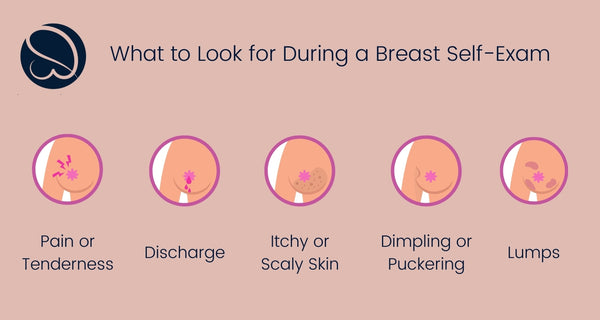on all orders over $99.99!
on all orders over $99.99!

Another month is rolling by, which means it’s nearly time for another monthly breast self-exam! “Feel it on the first” is more than just a catchy slogan— it’s a potentially life-saving habit that can help you catch breast cancer early.
Never performed a self-exam on your breasts? We’re here to show you how to do it and what to do if you see something abnormal.
You often hear the phrase “early detection is key” when talking about breast cancer— and it couldn’t be more true. Women whose breast cancer is detected early have a much higher survival rate than those who detect the cancer later. The longer cancer goes without being detected, the further it can spread, damaging other vital organs.
For the average woman over the age of 40, doctors typically recommend a mammogram every year. But a lot can happen between your annual mammograms, which is why it’s important to do a self-check.
Though it’s no replacement for a mammogram, research by Johns Hopkins Medical Center revealed that 40% of diagnosed breast cancers are detected by women who felt a lump. Self-checks can give you peace of mind each month and alert you to abnormalities that should be checked out by a doctor.
It’s good to get in the habit of doing a self-exam each and every month. The #FeelItOnTheFirst movement started on social media to encourage women to do their monthly breast check on the first day of every month.
With each breast exam that you perform, you will get more and more familiar with your body, which makes it easier to catch something unusual.
All you need to do a self-exam is a mirror and a place to lay down. Here’s how to do it and what to be on the lookout for.
Start by taking a look in the mirror without a shirt or bra on. Stand with your shoulders straight and your arms on your hips. Look for anything out of the ordinary like changes in breast shape, size, and color.
Lean forward and side to side. Examine your breast as you do so, looking for any abnormalities. This is also a good time to check for any discharge by gently squeezing your nipples.
Next, you’ll repeat the first step, but with your arms raised above your head.
While lying down flat on your back, use your fingers to firmly feel your breast. With the pads of your first three fingers, move in small circular motions, and check your breast from top to bottom and side to side. Be sure to cover the area from your collarbone to the top of your abdomen and from your armpit to cleavage. Use varying degrees of pressure to check the top of your breasts, the middle of your breasts, and the deep tissue in the back.
You can move along your breast in whatever pattern you're comfortable with. Just make sure to cover the entire breast.

Photo via Blausen Medical Communications — CC BY 3.0
You’ll want to repeat this process while standing or sitting with your arm over your head. Many women find this easier if the skin is wet in the shower.
When performing a breast exam, you’re looking and feeling for breast changes and anything out of the ordinary. This means checking for:

If you do experience any abnormalities, don’t panic. There are numerous conditions that aren’t breast cancer that can cause similar symptoms. Even if you find a lump, it does not mean cancer. Of all breast lumps found in women, about 60% to 80% are benign, or non-cancerous.
You will, however, want to see your gynecologist or primary care doctor— especially if the condition has lasted longer than one menstrual cycle if you menstruate. During your appointment, if your doctor finds reason to be concerned, they may order additional tests such as a diagnostic mammogram or biopsy.
A self-exam of your breasts may be your first line of detection for breast cancer. With statistics showing the importance of early detection, there’s no reason not to take a few minutes out of your day to do a quick check and #FeelItOnTheFirst!